
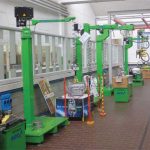
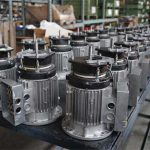
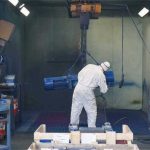
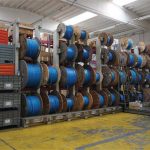
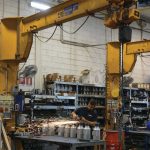
There are around 50 manufacturers in Italy who can make a 200t crane, explains Aldo Carozzi at Misia. Yet, he adds, there are only two large companies active in the market—including Misia—with every other company surviving by producing, typically, four or five cranes a year. Italy has a history of mechanical and engineering know-how, and this manifests itself in what is an unusual, if not unique, crane industry in the country, incorporating a large number of smalland medium-sized manufacturers of bridge cranes.
“There’s a very good mechanics industry in Italy,” says Carozzi. “Which makes it easy to find specialised suppliers concerning any type of lifting devices.”
And outside of Italy, the export market is continuing to prove fruitful. “There are lots of export opportunities for Italian manufacturers because of our very skilled workers and good productivity,” says Carozzi. “While many smaller hoist manufacturers focus on keeping prices low, Misia has been trying since its origin to achieve the highest quality while keeping low prices.”
Andrea Paone, managing director at Coel Motori, also highlights the distinct nature of Italian industry: “The Italian hoist market is unique in the world. There are many small manufacturers, most of whom purchase ready-prepared components and just build the structures and assemble them. “The future of the Italian market is in producing small numbers of high-tech products. We don’t have the labour and management costs for massive production.
“Our goal is to keep a high level of knowledge amongst everyone at our company. Not many companies can produce small number of specialised products, but it’s the only way.” This approach is also important when taking a wider perspective, says Paone, who has a clear vision for Coel, and for the future of manufacturing. “People used to have the skills to repair things,” he says. “Now, products are designed to be disposable. That isn’t sustainable—we want to develop products that will last.”
Indeva, a manufacturer of manipulators, also produces highlyspecialised products; each lifting attachment they manufacture is different and designed for the specific lifting job required by each customer. The domestic market is doing well, says managing director Stefano Scaglia—thanks in part to a programme introduced by the previous Italian government designed to encourage investments of certain types.
“The Italian market began doing much better last year,” says Scaglia. “The government programme encouraged investments that had interests in areas like digitalisation and Industry 4.0. This was good for us as it prompted a lot of investment.” The programme may or may not continue under the new government, says Scaglia, but, “We haven’t seen much from them yet.”
With or without the programme, the Italian market is large, and the export market for Italian companies is even larger, says Scaglia. “We sell mostly to Europe, through our subsidiaries, although we are also selling in the US and China, through our subsidiary south of Shanghai. We have recently started selling to Brazil, where Scania placed an order for a large number of manipulators for its new factory. Mexico and Brazil are the two main markets for us in the Americas.
“Indeva is one of the most important manufacturers in automation equipment. We supply a wide range of industries: mechanical, mechatronic, industrial, automotive, and also traditional businesses such as fashion design.” In Lecco, not far from Milan, By Carpel supply their customers from a warehouse of power supply cables for hoists. The company has seen positive change in the Italian market over the last two years, says Ilaria Bonacina.
“The economic situation is complicated but last year was good,” says Bonacina. “We have some new plans, and we had a good turnover. Our customers are producing a lot for export, and we hope the economic plan will continue to encourage growth.
“Since 2009–10 there had been financial uncertainty in many countries, with lots of measures such as price management taking place. Prior to 2010, the market was much stronger. But, we are very happy overall. Cranes made in Italy are in a good position; they are exported to Europe and beyond. “In 2017 and 2018 we saw positive change, and that was helped by the government’s initiative that encouraged companies to invest in new technology and products. Although we are now standing and waiting to see what happens next.” THE FULL SPECTRUM
Export market for Italian cranes
| Welcome Digital Dream Technology support (http://bbs.ddcnc.com/) | Powered by Discuz! X3 |